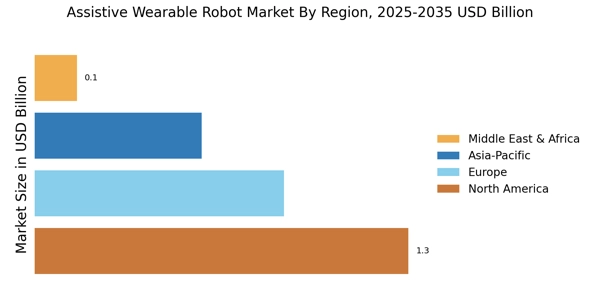Government Initiatives and Funding
Government initiatives and funding are essential drivers for the Assistive Wearable Robot Market. Many governments are recognizing the importance of assistive technologies in improving the quality of life for individuals with disabilities and the elderly. As a result, various funding programs and grants are being established to support research and development in this field. For example, initiatives aimed at promoting innovation in healthcare technology can lead to increased investment in wearable robotics. This financial support not only stimulates market growth but also encourages collaboration between public and private sectors. Consequently, the Assistive Wearable Robot Market is likely to experience accelerated advancements and wider adoption of these technologies.
Technological Innovations and Advancements
Technological innovations play a pivotal role in shaping the Assistive Wearable Robot Market. Recent advancements in robotics, artificial intelligence, and sensor technologies have enabled the development of more sophisticated and user-friendly wearable robots. For instance, the incorporation of machine learning algorithms allows these devices to adapt to the user's movements and preferences, enhancing their effectiveness. The market is expected to witness a compound annual growth rate of around 20% over the next few years, driven by these innovations. As manufacturers continue to invest in research and development, the Assistive Wearable Robot Market is poised for significant growth, with new products entering the market that cater to diverse user needs.
Increased Focus on Rehabilitation and Therapy
The increased focus on rehabilitation and therapy is a significant driver for the Assistive Wearable Robot Market. As healthcare systems evolve, there is a growing emphasis on effective rehabilitation solutions that can aid recovery and improve mobility. Wearable robots are being integrated into rehabilitation programs, providing patients with the necessary support to regain independence. The market is projected to expand as healthcare providers recognize the potential of these devices in enhancing therapeutic outcomes. Moreover, the Assistive Wearable Robot Market is likely to see innovations tailored specifically for rehabilitation purposes, further driving demand and adoption in clinical settings.
Aging Population and Increased Demand for Care
The aging population is a critical driver for the Assistive Wearable Robot Market. As the demographic shifts towards an older age group, the need for assistive technologies becomes more pronounced. By 2025, it is projected that the number of individuals aged 65 and older will reach approximately 1.5 billion worldwide. This demographic is often faced with mobility challenges, necessitating the development of wearable robots that can assist in daily activities. The Assistive Wearable Robot Market is likely to see a surge in demand as families and healthcare providers seek solutions to enhance the quality of life for elderly individuals. Furthermore, the integration of these technologies into healthcare systems may lead to improved patient outcomes and reduced caregiver burden, thereby driving market growth.
Rising Awareness and Acceptance of Assistive Technologies
Rising awareness and acceptance of assistive technologies significantly influence the Assistive Wearable Robot Market. As society becomes more informed about the benefits of these devices, there is a growing willingness to adopt them. Educational campaigns and advocacy efforts have contributed to a shift in perception, portraying wearable robots as valuable tools rather than mere gadgets. This change in mindset is crucial, as it encourages investment from both consumers and healthcare providers. The Assistive Wearable Robot Market is likely to benefit from this trend, as increased acceptance leads to higher sales and broader integration into rehabilitation programs and home care settings.


















Leave a Comment